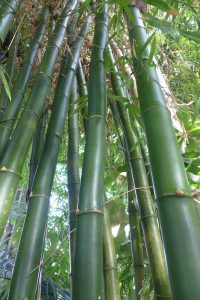Bamboo
Bambusa vulgaris
Family: Poaceae
Bamboos are essentially a group of toughened grasses. Botanically known as Bambusa vulgaris, it is described as an open, clump type bamboo species having lemon-yellow, green-striped culms (stems), bearing dark green leaves.
The plant can grow up to a height of 12 meters, with an 8cm thickness.
New culms shoot up in mid-summer and attain full height in less than 60 days.
Place of origin: The Bamboo is native to the Himalayas, but is now cultivated widely throughout Tropical Asia and America. It is also present in the regions ranging from Sierra Leone to South Nigeria and other African territories.
Did you know?
Bambusa vulgaris is widely planted and used for a variety of purposes, primarily for the use in the construction of houses, huts, bridges (there’s one suspension bridge in Sichuan province, China which is at least a thousand years old) and boats (incl. masts, rudders, outriggers and boating poles). It is also used in fences, scaffolding, furniture and handicrafts. It has even been used to make lightweight bicycle frames and fly fishing rods.
Bamboo is a favourite food for the Giant Panda and Bale monkey. Bamboo is the fastest growing plant and this has led to its use as a torture plant. It grows inside the body for 2-4 days if conditions are right and the poor person subjected to this form of torture would have an excruciating death. The grass can also be made into biomass and charcoal. A power station in the Philippines runs on bamboo chips. Clearly it has potential as a fue
l as it also makes good charcoal which is a deodoriser.

